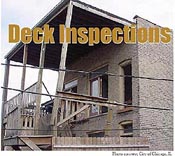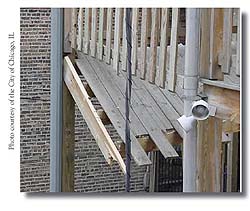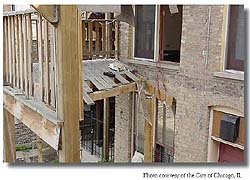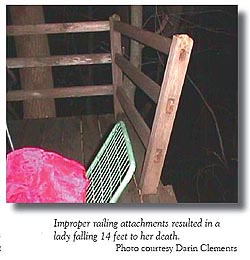
|
P.O. Box 829 Quakertown, PA 18951 Phone and Fax: 888.NADRA4U (888.623.7248) |
 DECK INSPECTIONS
DECK INSPECTIONSA MATTER OF LIFE AND DEATH by Anne W. West Reprinted with permission from Professional Deck Builders Magazine.
The headlines scream "preventable." These headlines often begin, "Deck
[Porch, Balcony] Collapses", and end with words like,
"Killed...Injured...Hurt...Dead." And, due to increased load, these events
often occur when maximum numbers of people are exposed to harm: wedding
receptions, parties, family barbecues, even wakes.
These tragic stories all demonstrate the importance of building
inspections of new and existing decks and why this step can literally
save lives. Take, for example, a deck collapse that injured six people
in Elyria, Ohio, in June 2004. The building inspector's report, filed
just hours before the collapse, read, "The balcony's beams were badly
rotted and work done earlier in the day to shore up the rotted beams did
nothing to resolve the structural problem."
It's estimated that 2.5 million new or replacement decks were built last
year. Almost every new home being built today includes an elevated deck
or porch. And, existing decks on older homes are being replaced at a
very high rate. In fact, the number of personal injuries and deaths
related to decks each year is likely to continue to rise because more
decks are being constructed each year and existing decks are deteriorating.
The International Code Council (ICC) suggests looking for the following
when inspecting decks, balconies, or porches: split or rotting wood;
loose or missing nails, screws, or anchors where the structure is
attached to the building; missing, damaged, or loose support beams and
planking; and, wobbly handrails or guardrails.
CONNECTIONS ARE CRITICAL ELEMENT
Mark Schwarzwalter, Senior Building Inspector, City of Sammamish,
Washington, often sees ledger problems during his inspections. "The
ledger attachment has not been done according to the plans, the handrail
heights are not per code, or the builder hasn't requested the required
inspections," he said, citing the most frequent issues seen in the 175
decks that are inspected annually in Sammamish.
Nail connections can be a problem because, unlike bolts, nails can pull
out. The U. S. Forest Products Laboratory in Madison, Wisconsin,
studied five years of newspaper articles on deck collapses from around
the country while researching a deck-building manual. The research
showed that "nearly every collapsed deck had been attached with nails,
rather than bolts, and investigators had pinpointed nails as the cause
of the collapse."
Dozens were injured when the 12-year-old deck of an Atlanta mansion
collapsed during a Salvation Army party in 1995. One couple attending
the party sued, claiming the host allowed too many people to gather on
the wooden deck and that he should have warned them that the deck was
unsafe. After the collapse, a building inspector found that the
collapsed section had been attached with 12d nails - 3 1/4 inches long.
The tips of the nails had penetrated the 3/4 - inch siding but not the
cellulose beyond it. Unknown to the homeowner, the builder had not used
flashing and the wood behind the beam was rotten.
A screwed-in connection works differently than a nail by gaining
increased strength from the wedging action of wood fibers along the
entire length of the shaft. For every inch of penetration, lag bolts
have as much as nine times the pullout resistance of a nail. A thru bolt
gives even better resistance with its metal-to-metal connection. The
thru bolt is inserted in a drilled hole and fitted with a nut on the
other side. A washer on both sides spreads the pulling force over a
larger portion of the beam.
The screwed-in connections offer another benefit over nails. They resist
the expansion and contraction of the wood. They may, however, loosen
over time. Early signs of such loosening include a widening gap between
the house and the deck. With nails, the deck may fall without any
warning signs. Yet, bolts aren't without their own challenges. In fact,
lag bolts had been used on an elevated porch on a Chicago apartment
building. When that porch collapsed on June 29, 2003, 13 people were
killed and more than 40 were injured. Inspections showed the lag bolts
were actually bent. "If you don't get it exactly right, they (lag bolts)
are worthless," said David J. Kupets, a partner with Kupets & DeCaro,
the Chicago law firm representing several victims of the collapse.
"There's a lot of detail about attachments, but building codes and
construction documents still don't give an appropriate use of ledger
board with masonry structures." He likens the lag bolt failure to an
improperly installed expansion hanger for a large piece of art. The hole
in the wall gets bigger and the hanger cannot expand enough to establish
a rigid position.


FLASHING CAN FAIL Many inspectors strongly discourage placing a deck directly under the sill of an exterior door. "We suggest about a four-inch distance between the threshold and the top of the deck to keep water from getting under the threshold and eventually rotting out the sub flooring," Robertson said. Because holes made in the side of the house, even when filled with a bolt, may allow water to seep in, builders should fill holes drilled for bolts with a durable caulk such as silicone. It's also important to pay close attention to products that are used in flashing. "We look for rubber or copper in flashing, and we are working to educate the public on the danger of mixing aluminum flashing with the new treated wood products," said Tom Elliott, building official, City of Charlottesville, Virginia. He says his team, which inspects about 450 decks a year, spends as much as 60 percent of their time educating others on the details of building codes. Recent changes in the chemicals used in the manufacture of treated wood have had an impact on materials used in flashing. According to the lumber and fastener industry, the newer chemicals being used to treat wood, alkaline copper quaternary (ACQ) and copper azole, are considerably more corrosive than wood previously treated with chromated copper arsenate (CCA). This means special attention must be paid to fasteners, hangers, and other materials that may come in contact with the wood because aluminum flashing actually deteriorates and dissolves when it comes in contact with treated wood.
The height of the railing is also regulated, with a height of 36 inches standard for residential properties and 42 or 48 inches most common for commercial and fencing applications. Builders must understand loading and how to properly attach railings. "We're particularly leery of installing the vertical guard rail members so that they aren't attached to the deck framing and the top and bottom rails and the verticals are not attached to the deck surface," Robertson noted, pointing out that this method doesn't typically withstand the IRC's 200 pound code requirement for rails to resist a load. "Weíre also seeing some deck builders who are notching the deck posts that extend from the footing and form part of the guard rail to accommodate another member. They don't realize that they are in effect creating the weakest point in that post because of the notch. We advise builders that we will not accept any type of support post with a notch in it." Charlottesville Building Inspector, Darin Clements knows first-hand the problems caused by weak support posts. In December 2003, he was called to an emergency where an older deck guardrail had failed and a woman had fallen 14 feet to her death. "The attachments failed where the guardrail support posts were attached to the deck and where the guardrail was attached to support posts," he said. After the tragedy, Clements suggested that the inspection staff carry photos of that deck failure to help explain the importance of proper railing attachments.
INSPECTIONS NOW AVOID PROBLEMS LATER Charlottesville Building Inspector and Plan Reviewer, Denise Burgess agrees with the need to fully understand the scope of the building project as well as the intended use of the deck. She works with homeowners and builders to better understand how the deck is going to be built even after she has seen their drawings. "We are now seeing more guardrails and supporting posts installed to code and per our instructions," she added. The ICC recommends that homeowners, condominium owners, and apartment dwellers visually inspect porches, balconies, elevated freestanding decks, and similar structures at least twice a year. "From a structural design and building code standpoint, an elevated deck is the most challenging element of a house, because the vertical and lateral load support system and railing system are not addressed by prescriptive details in the model building codes. "Load requirements are given in the IRC, but construction details needed to satisfy the design loads are not presently in the code," said Frank Woeste, P.E., Professor Emeritus at Virginia Tech. Woeste's summation shows how critical construction plans, permits, and inspections can be to a deck's structural integrity. Both new and replacement decks require a building permit before construction begins. Although specifics vary by locality, required inspections are typically for footings (before pouring concrete), framing and final completion. Other code inspections, such as an electrical inspection, may be required based on the deck design. Robertson's team works to make inspections convenient for builders. "Permit holders can call us for both inspections (footings and framing/final) at the same time if they leave the footings open so we can see what was used for footing and we can check footing and framing at the same time," said Robertson. "We can combine framing and final inspections because everything is visible at that time, unlike a house where walls would cover up framing." So complicated is the inspection of residential decks, balconies, and porches that researchers at Virginia Tech produced the Manual for the Inspection of Residential Wood Decks and Balconies in 2003. The manual was published by the Forest Products Society in cooperation with the ICC. Researchers for the project investigated eight decks and balconies in Virginia and found that not one met all code provisions based on the 2000 IRC, which was adopted by the State of Virginia in 2003 as the model code for residential construction. The latest versions (2000 or 2003) of the IRC, deemed the industry standard, have been adopted by many localities. Many communities make amendments to the model IRC to accommodate specific issues in their geographic area. For example, Virginia amended the section dealing with stair geometry. Code development and amendments occur at the local and state level. Deck builders have several opportunities to participate through public hearings and other public input vehicles. Robertson encourages builders to participate in the process. "With respect to the permitting and inspection process, the building inspector is not the builder's adversary. He is your partner because we are both trying to achieve the same thing," he said. Many communities are putting codes and details of the permitting and inspection processes online to make it easier for the builder. For example, the City of Sammamish posts local amendments to the IRC on its Web site at www. ci.sammamish.wa.us. "Information can also be found at a Web site shared by nine cities in our area," said Jan Vogee, building official, City of Sammamish. "The Eastside Building Officials Partnership provides tip sheets, inspection checklists, and some online permits at www.mybuildingpermit.com."
KEEPING UP WITH CHANGES The results of good construction, building inspection, and plan review are often unseen, according to Elliott. "The absence of TV news reports of building code-related accidents and no calls from attorneys concerning those accidents are peripheral goals of every inspector," he said. Robertson summed up why deck inspections are so critical. "No one wants to build an unsafe deck and that's what it's all about." And as deck collapses continue to make headlines, the focus on safety and the quality of deck construction is bound to be strengthened.
Re-printed courtesy of Professional Deck Builder Magazine. Published
bi-monthly, Professional Deck Builder Magazine strives to educate and
inform professional deck, dock, and railing builders; to provide a venue
for manufacturers and suppliers to reach their buyers; and to contribute
to the growth and professionalism of the industry. For your free*
subscription
call 678-344-6283. |
Return to the Index of Consumer Information and Articles
Membership Application ·
Board Members ·
Membership Benefits ·
Photo Gallery ·
Committees
Events Calendar ·
Industry News ·
Contact NADRA ·
Home
 RAILINGS ALSO REQUIRE ATTENTION
RAILINGS ALSO REQUIRE ATTENTION